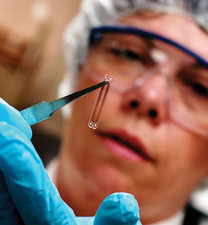No. 9: A sensor that guards your heart

For heart failure patients, closely watching cardiac health is the difference between life and death. Symptoms like a change in weight or blood pressure can point to a worsening condition — but not always soon enough.
Now, a breakthrough medical device invented at Georgia Tech sends reports of heart health straight from the pulmonary artery. This miniature wireless sensor, called CardioMEMS HF System, goes where human eyes can’t … to report on symptoms a patient has yet to feel.
Developed by Dr. Jay Yadav, a cardiologist, and Mark Allen, formerly a professor of electrical engineering, the device is based on a technology called MEMS (micro-electro-mechanical systems). MEMS uses micro-machining fabrication to craft an electrical system with components smaller than a human hair, so that key functions fit together on a single chip.
MEMS was originally developed for integrated circuits in computers, but Yadav and Allen believed it would offer an ideal platform for an implantable medical device. Because of its tiny tech, the entire CardioMEMS implant is the size of a small paperclip.
The device is implanted in a patient’s pulmonary artery through a catheter — no surgery required. It uses wireless communications technology to transmit data on cardiac output, blood pressure and heart rate to the patient’s doctor, who can then monitor the patient’s health from afar as well as suggest more personally tailored treatment plans.
The FDA approved the CardioMEMS HF system in 2014, and the technology has proven its worth: A recent clinical trial demonstrated a 37 percent reduction in hospitalizations for patients with the implant. St. Jude Medical acquired CardioMEMS in 2014 for more than $450 million and is now putting the new device to work for heart patient health.
